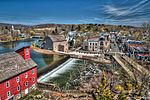Dunham's Mill

Dunham's Mill, also known as Parry's Mill, is a historic building located at 7 Lower Center Street in Clinton, New Jersey, United States. The gristmill was in operation from 1837 to 1952. It was added to the National Register of Historic Places on April 15, 1982, for its significance in commerce and industry. In 1995, it was also listed as a contributing property of the Clinton Historic District. It shares the Clinton Dam across the South Branch Raritan River with the David McKinney Mill (now known as the Red Mill) on the other side of the river. Since 1952, it has been home to the Hunterdon Art Museum, described by an art critic as the "most charming and picturesque" museum in the state.
Excerpt from the Wikipedia article Dunham's Mill (License: CC BY-SA 3.0, Authors, Images).Dunham's Mill
Lower Center Street,
Geographical coordinates (GPS) Address Nearby Places Show on map
Geographical coordinates (GPS)
| Latitude | Longitude |
|---|---|
| N 40.636388888889 ° | E -74.911944444444 ° |
Address
Hunterdon Art Museum
Lower Center Street 7
08809
New Jersey, United States
Open on Google Maps








